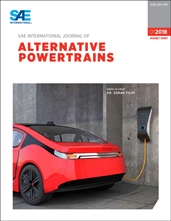Response surface methodology (RSM) techniques were applied to develop a predictive model of electric vehicle (EV) energy consumption over the Environmental Protection Agency's (EPA) standardized drive cycles. The model is based on measurements from a synthetic composite drive cycle. The synthetic drive cycle is a minimized statistical composite of the standardized urban (UDDS), highway (HWFET), and US06 cycles. The composite synthetic drive cycle is 20 minutes in length thereby reducing testing time of the three standard EPA cycles by over 55%. Vehicle speed and acceleration were used as model inputs for a third order least squared regression model predicting vehicle battery power output as a function of the drive cycle.
The approach reduced three cycles and 46 minutes of drive time to a single test of 20 minutes. Application of response surface modeling to the synthetic drive cycle is shown to predict energy consumption of the three EPA cycles within 2.6% of the actual measured values. Additionally, the response model may be used to predict energy consumption of any cycle within the speed/acceleration envelope of the synthetic cycle. This technique results in reducing test time, which additionally provides a model that may be used to expand the analysis and understanding of the vehicle under consideration.
